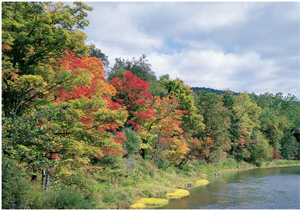Wood and LEED v4
Comparing Wood, Steel and Concrete

Wood harvested from properly managed forests offers one of the most eco-friendly LCAs, as compared with other building materials.
“When compared with steel and concrete, wood has a huge advantage from an environmental perspective,” states Jennifer Borgesi, LEED AP BD+C, contract manager, Trudeau Architects, Latham, N.Y.
“Wood from a properly managed forest is hard to beat in terms of its life-cycle impacts,” agrees Douglas Pierce, AIA, LEED FELLOW, SMaRT AP, senior project architect, senior associate, Perkins+Will, Minneapolis. “A properly managed forest can create habitat, sequester carbon, cleanse the air and even expand its net raw material stocks, all the while producing economically relevant levels of timber. On top of that, timber has the potential to be harvested and processed with modest amounts of green fuels and energy.”
Assuming that a tree is responsibly forested and another one is planted in its place, wood is derived from a renewable resource, and the energy required to produce another tree is virtually zero. In addition, wood manufacturing plants often use scrap wood as a bio-fuel to run the manufacturing operations, thereby requiring less fossil fuel to power the plant.
“During its life, a tree will actually absorb carbon dioxide,” explains Borgesi. “If the tree is left to die, it will then release this carbon dioxide back into the atmosphere. However, if the tree is used to make a building material, the carbon dioxide will stay trapped in the wood, thus reducing the amount of carbon dioxide released from this resource.”
At the same time, Grant points out carbon accounting may be skewed by current models which fail to fully take into account the fact that extensive clear-cutting and slash burning release more biogenic forest carbon than less intensive, more responsible forest management.
As a whole, however, the American Wood Council reports that U.S. reforestation and tree growth is currently exceeding tree harvesting by almost 40 percent, and that every ton of wood material used in construction saves approximately 5.7 tons of carbon dioxide from being released into the atmosphere.
“Wood outperforms other building materials by a wide margin in almost every impact category based on ISO-compliant life cycle assessments,” states Bowyer.
In addition, a study—commissioned by the Canadian Wood Council and performed by the Athena Sustainable Materials Institute, a nonprofit research collaborative specializing in LCAs—theoretically compared homes built with wood, steel and concrete structural systems. An LCA of 20 years concluded that as compared with wood, steel and concrete respectively embody and consume 12 percent and 20 percent more energy, emit 15 percent and 29 percent more greenhouse gasses, release 10 percent and 12 percent more pollutants into the air, and generate 300 percent and 225 percent more water pollutants.
Although the data is compelling, practically speaking, Sarah Buffaloe, LEED specialist, U.S. Green Building Council, Washington, D.C., points out that in many cases, choosing a structural material is not determined based on LCA but rather the initial decision is based on factors like context, cost and required performance. Once the material type is chosen, then LCA is a useful tool to compare product strategies.
On the other side of the coin, some environmental concerns associated with wood are volatile organic compound emissions—as many manufactured wood products use resins which release formaldehyde when cured.
“Formaldehyde is used in pressed wood products such as particle board, plywood and fiberboard,” relates Dr. Luz Claudio, professor of preventive medicine and environmental health scientist, Mt. Sinai School of Medicine, New York. “Formaldehyde and other VOCs may trigger asthma in people, and it is suspected to cause cancer in humans and animals. Some people can develop allergic reactions and increased sensitivity. Skin and eye irritation are also known effects of these chemicals.”
Fortunately, California Air Resources Board formaldehyde regulations have driven manufacturers to come up with alternative resin technologies, and these substitutes have very much been embraced by the industry, reports Grant.









